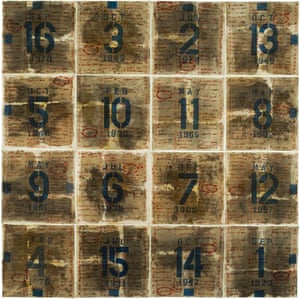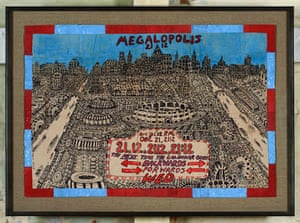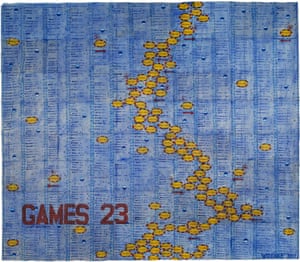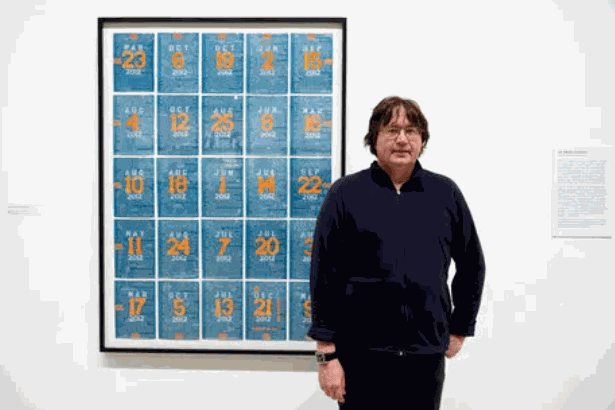All through his life George Widener has been fascinated with calendars.
"Other kids lined toys up in a row," he said. "I lined up dates."
Yet his fixation with calendars has ultimately turned him into a celebrated artist whose striking paintings of numbers, cities, maps and machines have been exhibited all around the world.
"[In my art] I am using the dates as the medium," he said.
I met Widener last week, and he walked me through Hayward Gallery in London, where his work is appearing in the exhibition The Alternative Guide to the Universe.
Widener has "savant syndrome", the general term for people who have high-functioning abilities coexisting with autism spectrum disorders. Perhaps the most famous savant was Kim Peek – the man about whom the film Rain Man was based – and Widener says that meeting Peek before he died was a turning point in his life. "I accepted that I could be myself and that was okay."
Widener's work lets us envisage the world as a savant does. One of his more recent interests is magic squares, which are squares of numbers such that each line, each column and each diagonal adds up to the same number.
For example, in the piece above, the top line is 23 + 6 + 19 + 2 + 15 = 65, and the first column is 23 + 4 + 10 + 11 + 17 = 65.
But Widener – who cannot see a number without turning it into a date – has turned the magic square into a grid of dates like a desk calendar. "I wondered if I could create a pattern of [dates of] disasters or of weather, and start predicting. Because if everything adds up, and there is one [date] missing, and a future date fits in … does that mean there will be storms? I got fascinated like that."
Widener not the first artist to use magic squares in art, nor to play with dates in one. In fact, Widener's magic square below is well known to mathematicians since it appears in Melencolia 1 by Albrecht Dürer, the Renaissance print whose date you will never forget since it is registered in the bottom line: 1514.

As a child growing up in Kentucky in the sixties, Widener exhibited
exceptional arithmetical skills. He was also a compulsive drawer with a photographic memory and an interest in machines.
He joined the US military at 18 to work in intelligence, based in West Germany, using his pattern recognition skills to analyse photos from the Stasi and the KGB. He was even flown to England to advise the British army during the Falklands War.
He says that he left the military because of his poor social skills and enrolled at the University of Texas to study engineering. But his mind was so full of numbers and dates that he was unable to cope with the course.
He ended up living in hostels and on the streets. "I began to get a bit obsessed with these things I had as a child, these numbers and stuff. They calmed me down in my times of stress. I sort of regressed. I started to retreat. I was filling my notebooks up with the dates. I had dozens of notebooks. I was keeping these notebooks in a backpack," he said.
Eventually he was put in hospital and diagnosed with Asperger's Syndrome, after which he says he became more able to accept who he was and control his obsession with dates.
One way he has channelled his arithmetical ability is in gambling. He has learned how to count cards, a system of winning at blackjack by memorising cards and calculating their values. He describes himself as a semi-professional gambler. "I have taken the casinos for thousands of dollars."
Another way he coped with his condition was by combining his interest in dates with his drawing. "I was lost. I was just [drawing] for myself. I didn't have any idea that people might enjoy it." He began to attract the attention of dealers and galleries, and became a prominent name in "outsider art" – a genre embracing self-taught artists with little or no contact with the mainstream. He uses unconventional materials such as, for example, paper napkins, and (in the top image) the typed pages of a 1945 thesis discarded from the Library of Congress.
"Art has been a relaxation for me. If I didn't have my art, I'd be in trouble man!"
Widener, who lives in the mountains of North Carolina, is attracted to patterns in dates, and has a particular love of palindromes – numbers which are the same backwards and forwards. For example, the 20th of February 2002, at 8.02pm is equally:
20/02/2002, 20:02
In order to commemorate that moment, Widener says he held his breath for 20.02 seconds. "I was in touch with it," he said.

In the nineties Widener began to get interested in the idea of the "singularity" – the point in the future, he estimates around 2050, where machines will become intelligent creatures.
He now says his art is for these future robot overlords. "They are going to need art too, and I am here to provide it.
"I felt I could be useful in a certain way, and use my system of dates as a medium for these intelligent machines of the future. And so I create these cities. I built these things on the structure of the specific dates involved. I am trying to reach out to these future machines."
The piece below, he explains, is a puzzle for robots. There is one date that is missing, and while it may be very difficult for a human to find the answer he thinks robots will find pleasure in it.
"Robots I believe will collect my work. But you don't need to be a robot to enjoy it."

